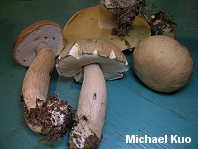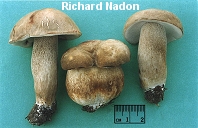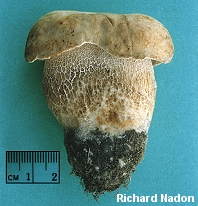| Major Groups > Boletes > Boletus > Edulis Group > Boletus variipes |

|
Boletus variipes [ Basidiomycetes > Boletales > Boletaceae > Boletus . . . ] by Michael Kuo One of several closely related mushrooms in the Boletus edulis group, Boletus variipes has a dry, tan to grayish brown cap that is very finely velvety when young, and often becomes finely patchy in age. The reticulation on its stem is often (but not always) prominent and whitish, contrasting with the brownish stem surface. It is found under oaks and other eastern hardwoods in eastern North America. Boletus variipes var. fagicola has a very dark brown cap and stem. It was originally recorded from Michigan by Smith & Thiers (1971), but is common throughout eastern North America, and was documented in Costa Rica by Halling in 1997. Description: Ecology: Mycorrhizal with hardwoods, especially oaks (occasionally reported, perhaps erroneously, with conifers); growing alone, scattered, or gregariously; late summer and fall; fairly widely distributed in eastern North America. Cap: 6-20 cm; convex, becoming broadly convex or almost flat; dry; finely velvety at first; often becoming minutely cracked in age; tan to brownish or pale grayish brown. Pore Surface: White when young, becoming yellowish or olive; not bruising; pores "stuffed" when young; 1-2 pores per mm at maturity; tubes 1-3 cm deep. Stem: 8-15 cm long; 1-3.5 cm thick; swollen in the middle, more or less equal, or enlarging to base; dry; solid; whitish or grayish brown; usually fairly prominently reticulate with whitish or brownish reticulation--or at times only finely reticulate. Flesh: White; not staining on exposure. Odor and Taste: Not distinctive. Chemical Reactions: Ammonia dark yellow with a purplish ring on cap surface; negative to grayish on flesh. KOH similar to ammonia on cap surface; grayish on flesh. Iron salts negative to pale olive on cap surface; gray to yellowish on flesh. Spore Print: Olive brown. Microscopic Features: Spores 9-16 (-18) x 4-6 µ; smooth; subfusiform. REFERENCES: Peck, 1888. (Coker & Beers, 1943; Snell & Dick, 1970; Smith & Thiers, 1971; Smith, Smith & Weber, 1981; Phillips, 1991/2005; Both, 1993; Horn, Kay & Abel, 1993; Bessette, Roody & Bessette, 2000; Halling & Mueller, 2003; Roody, 2003; McNeil, 2006; Binion et al., 2008.) This site contains no information about the edibility or toxicity of mushrooms. |
© MushroomExpert.Com |
|
Cite this page as: Kuo, M. (2010, March). Boletus variipes. Retrieved from the MushroomExpert.Com Web site: http://www.mushroomexpert.com/boletus_variipes.html |


